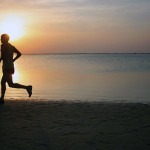Anyone who is a regular runner often faces a lot of embarrassing problems. These include diarrhea, sore nipples, rashes, etc. which we may not feel comfortable talking about openly. The bad thing here is, these are bound to happen when one runs weather it’s one thing or the other, but the good thing is, none of them are unavoidable.
With a few concerned steps and easy tricks, each of these embarrassing problems can be tackled with, easily. Check them out below:
1. Forgetting the path while running
Now this is not something which is highly uncommon, but it has been observed that a lot of people find it embarrassing to admit it. What you can do to avoid this problem? It’s really simple. First, if you intend to take a new route on a particular day, make sure you share the plan with at least one person you trust. Secondly, make sure you have a working Internet connection on your smartphone so that Google or any other maps can guide you, have some cash handy, so that you can take a cab, just in case, and carry some water. You’re good to go!
2. Snot!
This is one common problem faced by a lot of runners, especially during winters. The winters are bound to make you cold and make your nose drip. There’s nothing to be worried about, though. Here’s the solution – Place one finger over one nostril. Then, close your mouth, and breathe out through the unplugged nostril as hard as possible. Aim to the ground and behind you (or you’ll hit your foot). In case you’re running a race, PLEASE check if there’s someone behind you, since it is extremely gross!
Simpler alternative: Wipe it on your shirt sleeve!
3. Runner’s Trots (Runner’s diarrhea)
Anyone who runs regularly will know that it’s a real thing. People just get the urge to GO in the middle of their run, and sometimes it happens out of nervousness. The solution varies for different people. One has to understand what and how to eat before, during, and after runs, because you’ll need to apply that knowledge to race day. It goes unsaid that the meals have to suit your body. Generally, a peanut butter sandwich, a banana, and a cup of coffee an hour before a long run gives enough time to take your nature’s call. For many others who have a difficulty in digestion, they need to go for a lighter breakfast. In worst case scenario, even after taking all the precautions, you feel the need to go, don’t hesitate to use the nearby bush as a bathroom.
4. Menstrual concerns
A lot of women think they won’t be able to run fine, if they get their period on the day of the race due to the fear of menstrual cramps. The good news is, there’s no need to be afraid to run during your period. Studies have shown that indeed, running can actually improve your mood and alleviate physical symptoms before and during your period. In case you’re training for a big race, it is recommended that you plan to run when you have your period so you can see how it feels. It will alleviate some of the fear and nervousness if you have it for your race. Tampons are recommended over pads for comfort and to avoid chafing. Just make sure you carry an extra one on your long runs during that time of the month, and you’re good to go!
5. Chafing
This mostly happens during summers. It happens underarms and, or in between the two thighs. For this, apply Vaseline and Body Glide, which you can rub into your skin to make it slippery and therefore less likely to burn as it rubs against your other body parts or clothing happens to be a great solution. Not only that, even a chap stick also works well in a pinch, plus it’s super easy to carry it around. Another way to prevent this is to wear body tights/ undergarment specially designed for runners which sticks to the skin and reduces any chance of friction.
6. Sore or bloody nipples
It mostly happens when men run. Their nipples constantly rub against their shirt while running. Over the course of a run, this sensitive area can be rubbed to the point of bleeding or can result into sore nipples. For women, it is mostly never an issue as they wear tight fitting sports bras. To avoid, apply a lubricant like Vaseline or BodyGlide to the nipple area before a long run. Products such as Nip Guards or Band-aids can also be worn to protect the nipples. For longer runs, wear a synthetic-material (Dri-Fit, not cotton) shirt closest to your body. Cotton shirts will cause chafing. Women should make sure their sports bras are not cotton.
The next time you’re going for a run, make sure you keep these points on mind and you’ll be good to go! Run safe!






